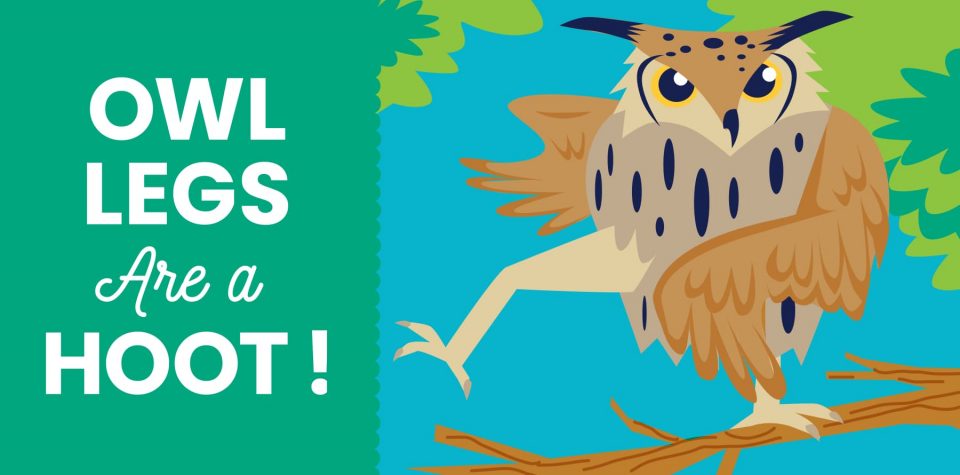
Owl Legs Are a Hoot!
Owl legs took the world by storm in 2017, when a photo of an owl with its feathers lifted up to show its long legs went viral on the internet. But there’s more to owl legs than being long and skinny. Adapted for flying, perching, and nocturnal hunting, owl legs vary in length by species and sport several unique features.
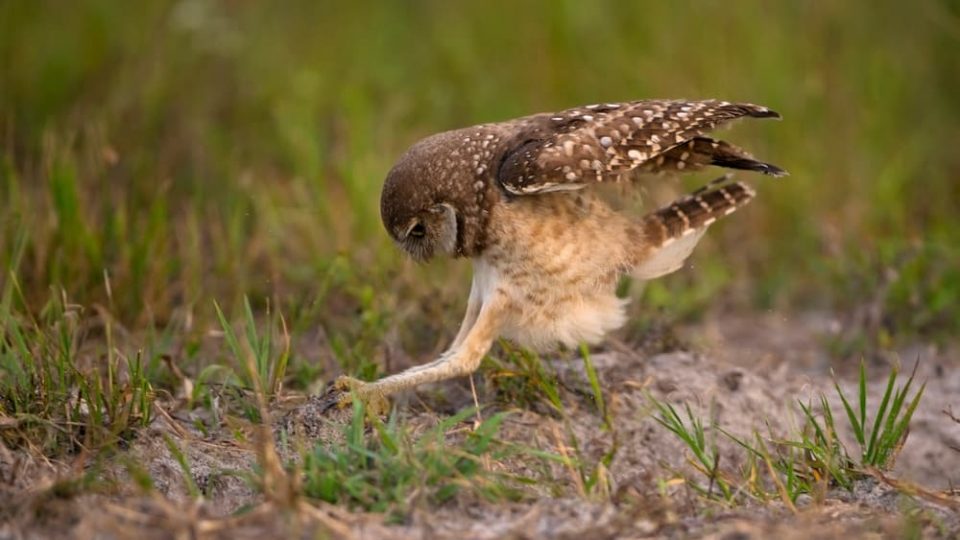
Why Do Owl Legs Seem So Long?
Owl legs seem surprisingly long because their feathers hide so much of them, but they’re not as long as the legs of many other birds, even other raptors (birds that seize prey). While the world’s largest owl, Blakiston’s fish owl, is less than two-and-a-half feet tall, the secretary bird—an African raptor—has such long legs that it stands over four feet tall! Like other raptors, owls have legs adapted for power, because they use their legs, feet, and long talons to grab their prey and pull it up into trees.
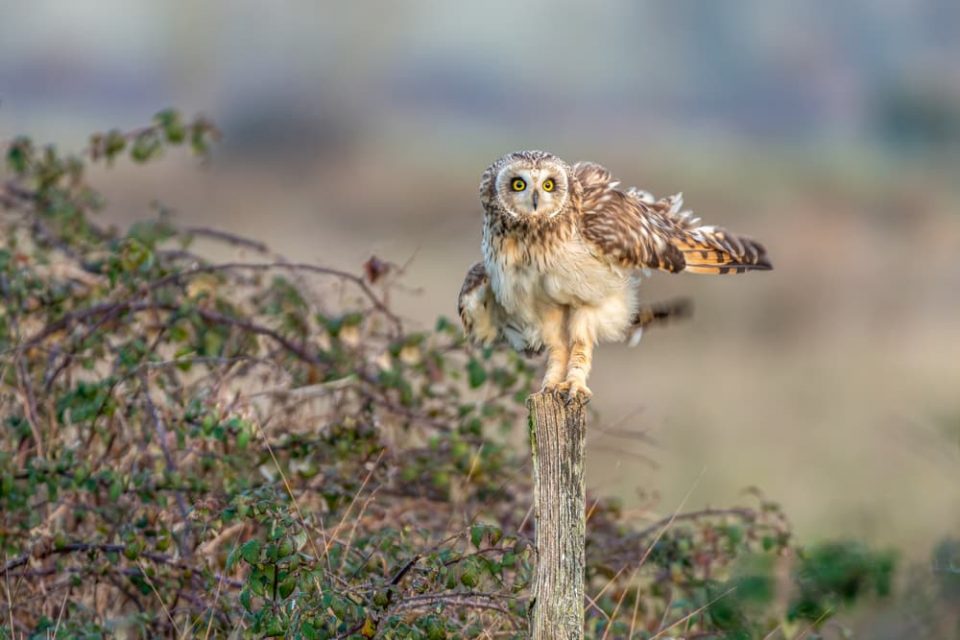
An owl’s legs are also covered by feathers until they reach the talons. Most other birds only have feathers partway down their legs. Feathered legs help owls stay warm when hunting at night in cold temperatures. They also muffle the sound of air moving over the legs and contribute to owls’ famously quiet flying.
Owl legs are cool, but they’re not the only interesting adaptation this bird has to show us.
Owl Wings
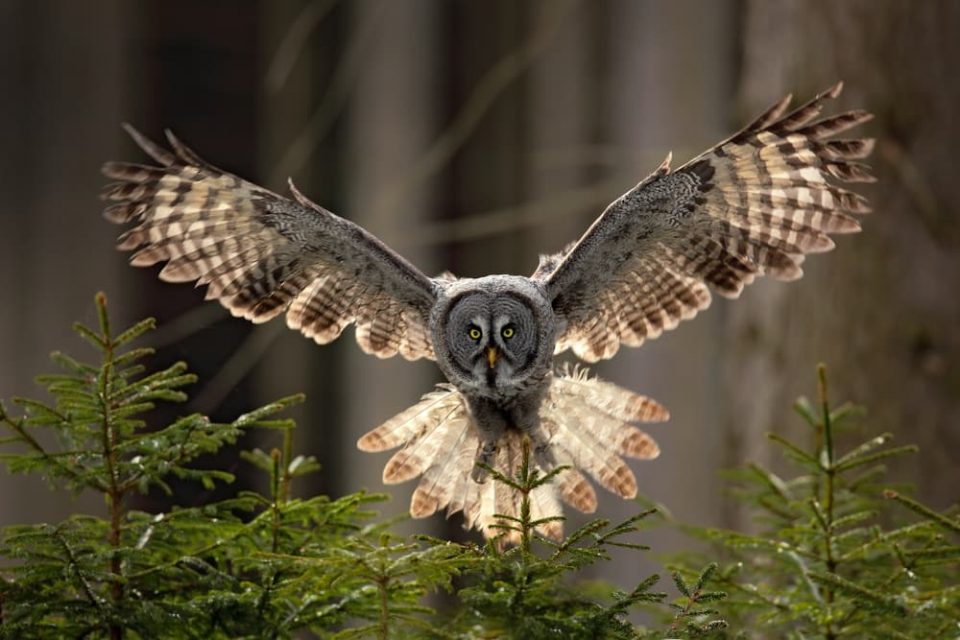
Owls are known for being incredibly quiet flyers. Most other birds as big and fast as owls make lots of noise when they fly. So what makes owl wings so quiet?
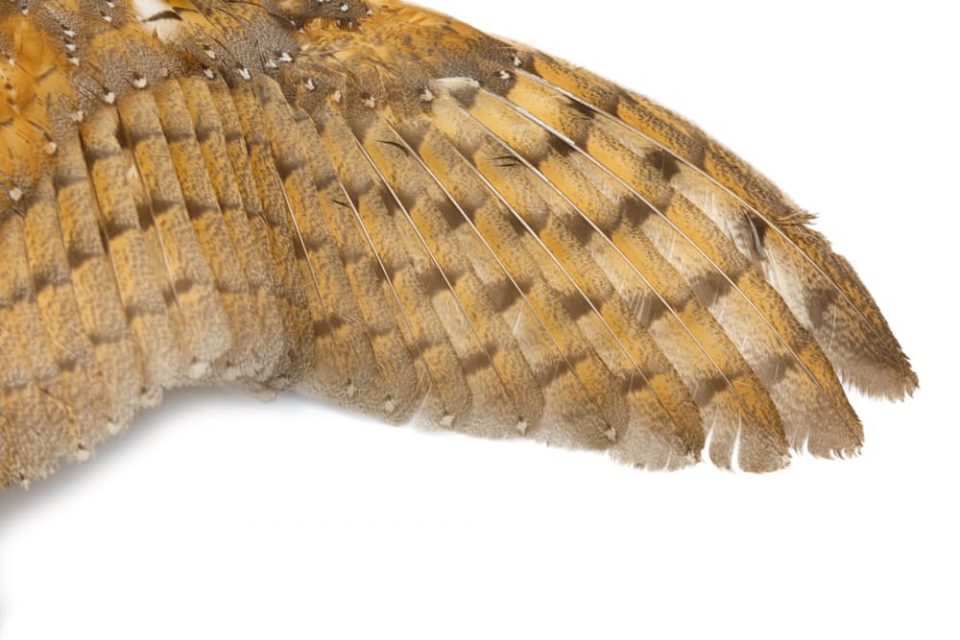
First, their feathers are serrated—they jut up and down like the edge of a saw. The serrated feathers break up the flow of air over an owl’s wings, making flight quieter. The velvety texture of an owl’s wings also helps deaden the sound they make when flying. If your home has velvet curtains, try flapping them around and compare that sound to the sound of something like a shower curtain. Softer materials are much quieter when they move through the air.
Second, owl wings are big, especially compared to the size of their bodies. This lets them fly slower and spend more time gliding than flapping. Flapping creates most of the sound that birds make in flight, so the less the owl flaps, the less noise it makes.
Scientists are still working out exactly why owls need such quiet wings, but they suspect it’s for two reasons: flying quietly makes it harder for their prey to hear them coming and helps them hear their prey.
Owl Ears
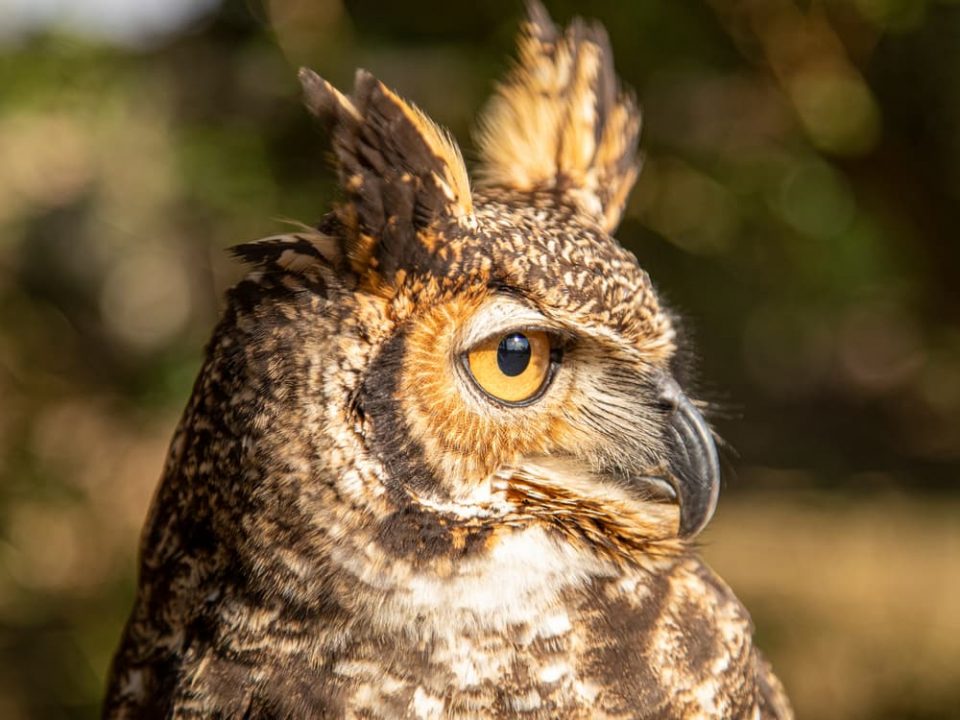
Owls have a sense of hearing and much more sensitive ears than most other birds. They need this to help them locate and hunt their prey.
Owls look like they have ears on top of their heads, but those are actually special bunches of feathers called ear tufts. Underneath their ear tufts, owl ears work a lot like human ears. Sound waves carried through the air vibrate an eardrum and a special bone, which then vibrate tiny hairs inside the ear, which send signals to the brain that translate as sounds.
Many species of owls also have ears set diagonally from one another—one toward the top of their skull on one side of their head and another toward the bottom of their skull on the opposite side of their head. Because owls hunt from above their prey, having their ears at different heights on their skull helps them figure out where their prey is. The sound of an animal skittering beneath fallen leaves or running through a grassy field reaches the lower ear first. By turning their heads and listening to how the sound changes, owls can locate their prey and swoop down to catch it.
Owl Skeletons
Owl skeletons contain some important adaptations as well. Like other birds, owls have lightweight bones—some of which are hollow—to help them fly. Their leg bones are especially strong, helping to absorb the impact of striking prey from above and providing support as the owl pulls its food into the air.
An owl’s skeleton also helps the bird perform an iconic trick: turning its head almost all the way around. In most animals, twisting the neck 270 degrees like the owl can would risk cutting off blood flow to the brain. But an owl’s neck bones contain extra space for blood vessels and air sacs, protecting them during extreme neck turns. Those bones also have space for reservoirs in the blood vessels, which scientists think allow extra blood to collect and flow to the brain when owls turn their necks.
Why Do Owls Hoot?
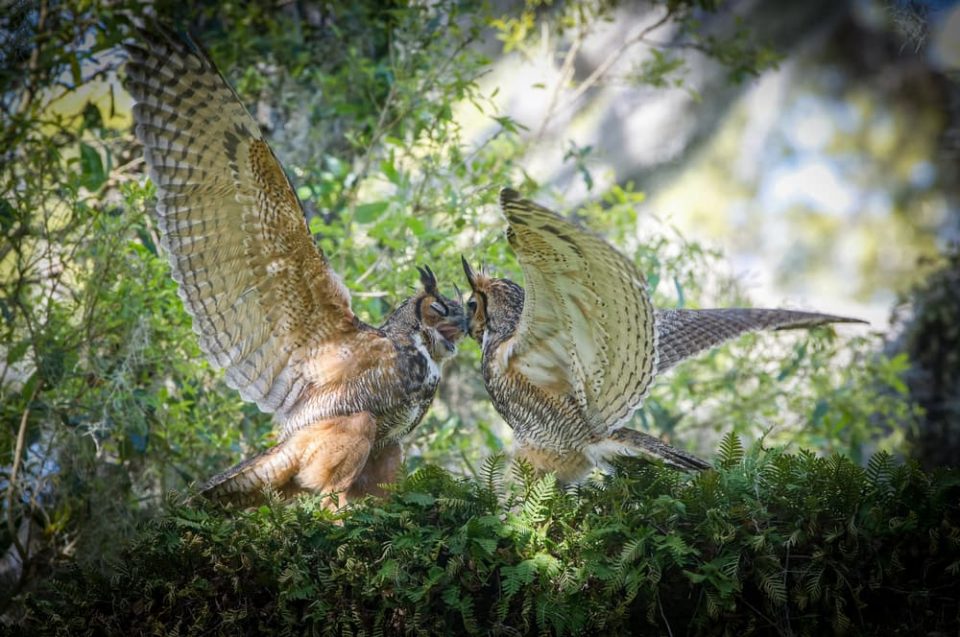
Owls make many sounds, but they’re known most for low, distinctive hoots which carry a long distance. They use these calls to establish territory, especially during mating season. Basically, they’re saying, “This is my spot! No other owls better look for a mate around here!” Once a male finds a female mate, she’ll hoot back in a duet, which sends another signal: “This is our nesting zone. No room for other owls here! Move on and find another!”
Different species of owls make very different hoots. The great horned owl makes the famous whoo-whoo-whoo call, but the eastern screech owl’s hoot sounds like a whinnying horse, and the burrowing owl makes a sound like a high-pitched woot-woot! Besides their hoots, owls also hiss, screech, bark, and make other sounds that range in meaning from “Give me food please, parents!” to “Get away from my nest, intruder!”
Together Time
Kids love surprises, and you can bring the surprise of an owl’s long legs to life with this paper bag owl puppet craft. It can move its head (with a kid’s help), and when you release the paper clips to extend its legs, watch out! The puppet will nearly double in height!
Little Passports Leg Surprise Paper Bag Owl Puppet
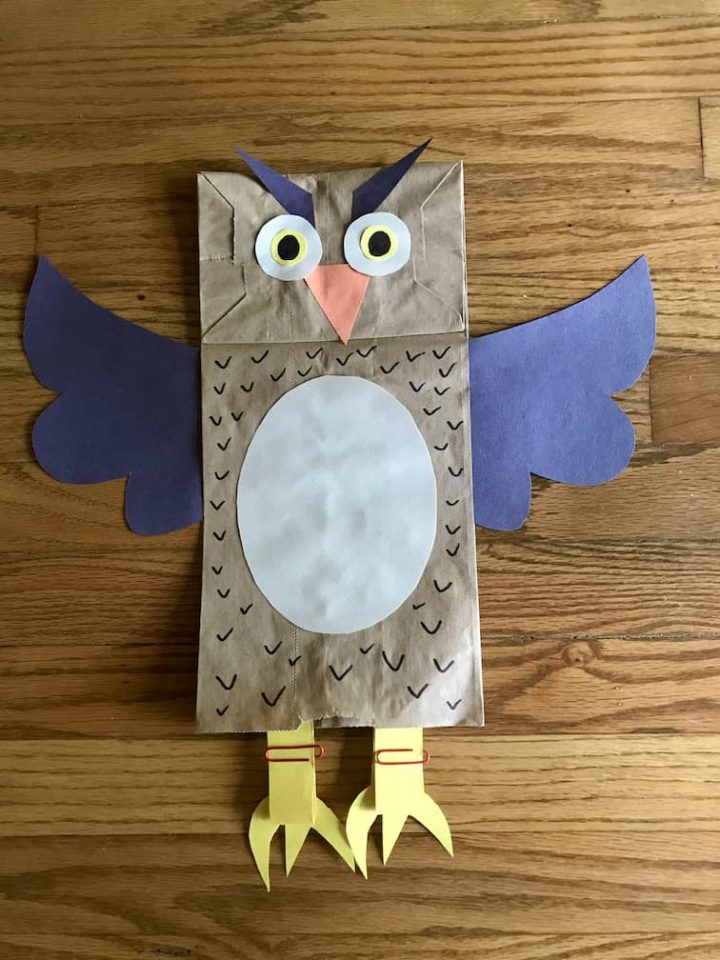
Supplies
Brown paper lunch bag
Construction paper in multiple colors
Child-safe scissors
Pencil
Black marker
Glue stick
Two small paper clips
Directions
Step one: Cut a light-colored oval (about 4 1/2” x 5 1/2”) out of a piece of construction paper. This will be the owl’s stomach. Place the lunch bag upside down with the bottom of the bag faceup. Glue the oval to the center of the lunch bag.
Step two: Use the black marker to draw little Vs all over the front of the bag for the feathers.
Step three: Fold a brown or gray piece of construction paper in half. Draw the outline of a wing in pencil, starting at the fold and drawing outward. Cut out the wing and unfold it. Cut along the fold line to separate the wings. Tuck the straight side of a wing between the folds at the side of the bag and glue in place. Repeat with the other wing.
Step four: Cut two small circles out of light-colored construction paper. These will be the owl’s eyes. Cut two smaller circles out of yellow construction paper. Glue the larger circles to the bottom of the bag to make the base of the eyes. Glue the smaller yellow circles on top. Use the black marker to draw on pupils.
Step five: Cut a triangle out of orange construction paper. Glue in place for the beak.
Step six: Cut eyebrows out of the same color of construction paper as the wings. Play around with different shapes to create different expressions on the owl’s face. Angling the eyebrows up or down can make a happy, sad, or angry owl. Choose your favorite eyebrows and glue them in place.
Step seven: Cut two strips (1” x 12”) out of yellow construction paper. Glue the top of each leg in place inside the bag, making sure at least eight inches of the legs dangle below the bottom of the paper bag.
Step eight: Cut two claw shapes out of yellow construction paper. Glue to the bottom of the legs.
Step nine: Accordion fold the legs up to the bottom of the bag and paper clip in place. This is an owl as it is usually seen. To show an owl standing tall, unclip the legs! Put your hand inside the paper bag to use your owl as a puppet. Move the owl’s head by moving your hand up and down inside the bottom of the bag.

